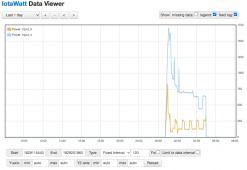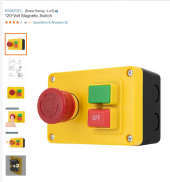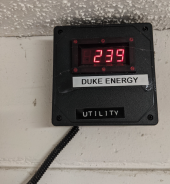Had an “opportunity” to run the house on the inverter/batteries for the first time this morning!
The new solar we have has been operational for a couple of months now.
Grid went down @ 01:30.
We woke up and waited a few minutes to see if the grid outage was just a blip.
After 5 or 10 minutes, we received a text from the power utility to expect the power to be restored by 07:30!
Normally we would just start the Diesel generator, throw the transfer switch, and go back to bed.
But we had only briefly tested the house load, one time, on the solar batteries, just long enough to make sure it worked.
The Diesel is noisy & smoky, generally nasty to operate.
So I went through the checklist to open the breakers for big loads, before throwing the switch to put the house on batteries:
- POOL PUMPS
- DRYER
- WASHER
- DISHWASHER
- HEAT PUMP
- RANGE
- WATER HEATER
I left the well pump breaker on, so we could have water.
You can see from the graph that I was eventually able to get the load below 1kw.
When I saw the initial house load of almost 2kw, I went room to room pulling out all the power plugs for everything not essential.
That worked to reduce the load.
Was surprised at the amount of electricity used by all the small things plugged in throughout the house.
Now I need to make a better plan to disconnect all that crap w/o moving furniture @ dark o’clock.
The grid came back around 05:00, and the batteries were @ 89%.
So we are very happy, and it seems that with better load management, the house could actually run all night on the batteries.
Feeling more confident this hurricane season.

The new solar we have has been operational for a couple of months now.
Grid went down @ 01:30.
We woke up and waited a few minutes to see if the grid outage was just a blip.
After 5 or 10 minutes, we received a text from the power utility to expect the power to be restored by 07:30!
Normally we would just start the Diesel generator, throw the transfer switch, and go back to bed.
But we had only briefly tested the house load, one time, on the solar batteries, just long enough to make sure it worked.
The Diesel is noisy & smoky, generally nasty to operate.
So I went through the checklist to open the breakers for big loads, before throwing the switch to put the house on batteries:
- POOL PUMPS
- DRYER
- WASHER
- DISHWASHER
- HEAT PUMP
- RANGE
- WATER HEATER
I left the well pump breaker on, so we could have water.
You can see from the graph that I was eventually able to get the load below 1kw.
When I saw the initial house load of almost 2kw, I went room to room pulling out all the power plugs for everything not essential.
That worked to reduce the load.
Was surprised at the amount of electricity used by all the small things plugged in throughout the house.
Now I need to make a better plan to disconnect all that crap w/o moving furniture @ dark o’clock.
The grid came back around 05:00, and the batteries were @ 89%.
So we are very happy, and it seems that with better load management, the house could actually run all night on the batteries.
Feeling more confident this hurricane season.





